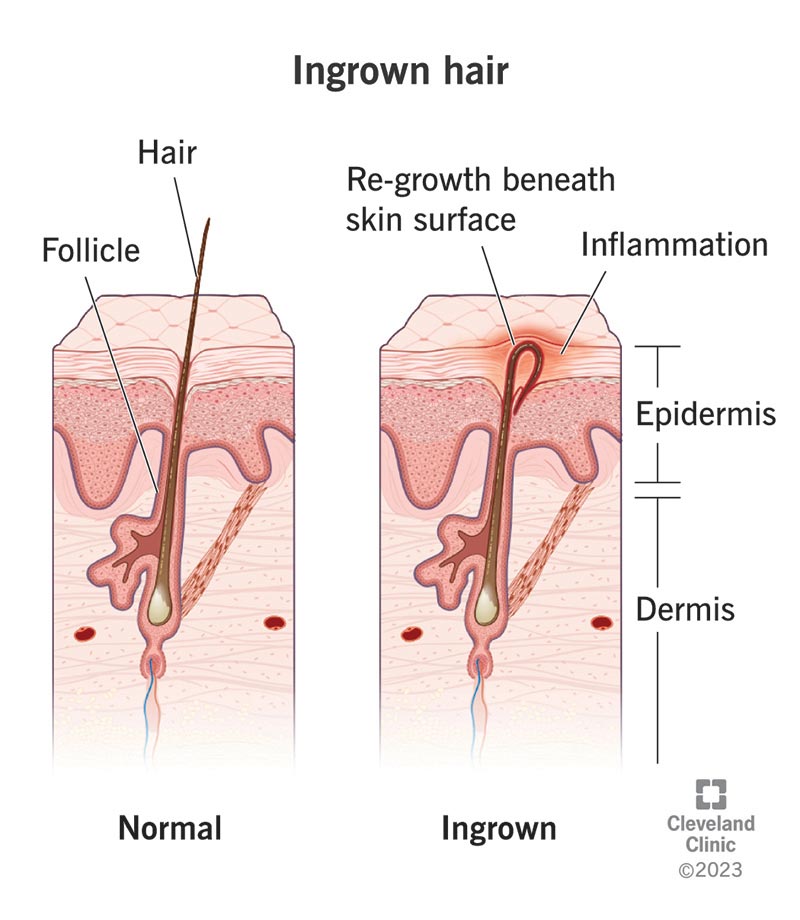An ingrown hair looks like a raised, discolored spot on your skin. It’s a strand of hair that grows back into your skin after shaving, tweezing or waxing. Ingrown hairs can affect anyone, but they’re easy to treat and prevent with the right hair removal practices.
Advertisement
Cleveland Clinic is a non-profit academic medical center. Advertising on our site helps support our mission. We do not endorse non-Cleveland Clinic products or services. Policy

An ingrown hair is a strand of hair that grows back into your skin after shaving, tweezing or waxing. They may be painful or itchy, and they commonly appear around your face, legs, armpits and pubic area.
Advertisement
Cleveland Clinic is a non-profit academic medical center. Advertising on our site helps support our mission. We do not endorse non-Cleveland Clinic products or services. Policy
Ingrown hairs are sometimes called razor bumps, shave bumps or barber bumps.
Ingrown hair is very common. Anyone who shaves, tweezes or waxes their hair can develop ingrown hairs. If you shave often, you’re more likely to have ingrown hairs.
You’re also more likely to have ingrown hair if you have skin of color or thick, coarse or curly hair.
The beard area of your face (neck, cheeks and chin), legs, armpits and pubic area (bikini line and inner thigh) are most likely to develop ingrown hairs. However, they may also appear on other parts of your body, including your scalp, chest, back, abdomen, inside of your nose (nostril), eyebrows and buttocks (butt).
The symptoms of ingrown hair include:
If an ingrown hair becomes infected, you may notice the bumps getting bigger and more painful. Pustules occur when there’s pus around the follicles. This infection can lead to scarring.
Removing hair by shaving, waxing or tweezing can cause ingrown hairs. New hairs grow from hair follicles under your skin. Shaving, waxing and tweezing only remove hair strands — they don’t remove hair follicles.
Advertisement
When new hair grows, it may curl back and enter your skin. This more commonly occurs if your hair is thick, curly or coarse.
No, ingrown hair isn’t contagious.
Ingrown hairs are easy to recognize, so you don’t necessarily need a healthcare provider to diagnose them. However, your healthcare provider can confirm them during a physical exam. They’ll note your appearance and symptoms, and they may ask questions about your skin and skin care routine, including:
There are several ways to treat ingrown hairs at home, including:
If your symptoms don’t improve, your healthcare provider may need to prescribe medications that decrease inflammation and improve infections.
In rare cases, your healthcare provider may use a sterile surgical knife with a thin blade (scalpel) to make a small cut in your affected areas. They’ll squeeze out any pus and use sterile tweezers to remove the ingrown hair.
To prevent scarring or infection, don’t pick at, scratch or pop your ingrown hairs.
To remove an ingrown hair, gently exfoliate your skin. Exfoliating your skin removes a dead layer of skin cells and helps release ingrown hairs. Use warm — not hot — water and small, circular motions to wash your affected areas with a washcloth, exfoliating brush or exfoliating gel or scrub.
You can also remove an ingrown hair that has looped or curled back into your skin by gently pulling it out with a sterile needle, pin or tweezers. Apply rubbing alcohol to your surrounding skin to prevent an infection. Then, carefully thread the sterile needle, pin or tweezers through the exposed hair loop. Gently lift the hair loop until one end releases from your skin.
In most cases, ingrown hairs usually heal themselves within one to two weeks with only minor irritation, as they eventually release from your skin as they grow longer. Infections can develop around the ingrown hair, causing pus formation, discoloration and pain, though. If you see signs of infection, you should visit your healthcare provider.
Advertisement
Your healthcare provider may provide medications that can decrease inflammation and improve infections from ingrown hairs, including:
For more serious cases, your healthcare provider may recommend other hair removal options, including:
Most ingrown hairs will go away on their own without treatment after a few days; though, severe cases may take several weeks.
Medications may take a few days to see results. The results of electrolysis and laser hair removal are immediate.
The best way to prevent ingrown hairs is to use proper hair removal techniques, including:
Advertisement
If your ingrown hairs aren’t going away with at-home treatments and a good skincare routine, or if you’re ingrown hairs become infected, call your healthcare provider.
Ingrown hairs are a common skin condition. They may appear anywhere hair grows on your body, but they commonly appear in places where you shave, tweeze or wax, especially your face, legs, armpits and pubic area. A good skin care routine helps prevent ingrown hairs from forming, while at-home treatments can help release the hair from underneath your skin and provide relief. Contact your healthcare provider if you notice any signs of infection.
Advertisement
Cleveland Clinic’s primary care providers offer lifelong medical care. From sinus infections and high blood pressure to preventive screening, we’re here for you.

Last reviewed on 03/04/2022.
Learn more about the Health Library and our editorial process.